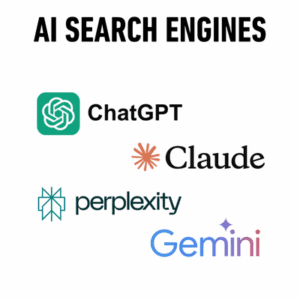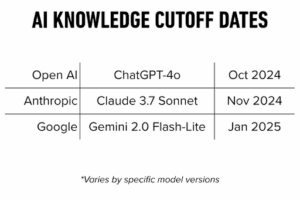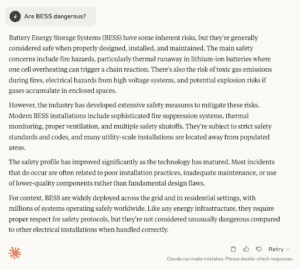How to get the right message to the right person when they ask an AI chatbot.
Right now, 15 million adults in the United States use generative artificial intelligence (AI) first to retrieve information online, according to Statista. What if they ask about your company, campaign or organization? Will it deliver true and accurate information?
AI search is exploding in size with most of the 1.3 billion search queries entered into Google every day returning some form of AI. For the past three decades we’ve been focused on search engine optimization (SEO), but now it’s time to add AI to the mix.


Brian Chen, The New York Times’ lead consumer technology writer, recently compared Google’s new AI mode to traditional search engines with mixed results:
“A traditional Google search is still best for the simple act of looking for things to do nearby, but AI Mode could prove to be a nifty tool for more tedious tasks like product research for online shopping — an instant chart comparing baby car seats is helpful, even if imperfect. Just always check the answers.”
Why This Matters For Advocacy Campaigns
For us, we’re not worried about product description or availability of services from a company. We are waging an information war. AI can either help contribute to misinformation around your campaign or be a powerful driver of filling information voids with an accurate narrative.
When we run advocacy campaigns for land use development, around health care policy or to influence legislation, we’re not just competing for online attention – we’re now competing for accuracy in AI responses. What happens when a city council member searches for information on data center energy usage or a journalist searches for historical knowledge of our client’s industry?
What Happens When People Search Versus Ask
Traditional search engines return results based on crawling and indexing live web pages. Behind the scenes of a search, Google’s crawler is reading and categorizing websites to return the most relevant and fastest information when asked. Once you enter a query into any search engine, it will find relevant web pages and return the information displayed there. In the most simple sense it’s a one-to-one return. You ask for X, it finds and returns X.
AI is fundamentally different because most models generate answers through pretrained knowledge combined with limited real time augmentation.
Most AI models are trained on massive amounts of data taken from the internet up until a certain “knowledge cutoff” date. As companies release new models the date updates, but is still never real time.


Once the model returns data from its existing knowledge, it conducts a limited real time search, similar to how you would on Google. This allows it to augment any missing information and correct factual inaccuracies.
Combining both of these pieces of information – knowledge and multiple real time searches – it returns a synthesized version. This is why AI search engine optimization can be trickier than the one-to-one traditional optimization.
Google’s newly introduced AI mode is particularly powerful using this method because it employs a “query fan-out” technique that returns results based on multiple searches of their structured data gathered from their crawler.
Compared to traditional one-to-one, AI searches require you to optimize your content for their historical knowledge and an undetermined number of interrelated queries.
How To Optimize For AI Searches
Despite this, it is still possible to influence the answer given. To start, ask an AI chatbot about an issue related to your company or organization. From this starting point, you can create a baseline assessment and identify the initial information sources they are using – either through deduction or seeing their hyperlinks.
Here’s one based on recent work we’ve done in Texas:


Remember this founding principle: you will never be able to feed AI an answer to a question. Instead, you want to make sure their sources are citation worthy and fact dense to inform their answer.
Because AI uses the “query fan-out” or similar technique, it might not pull from only your website. You’ll want to optimize across your owned properties like websites, landing pages and blogs, extended properties like social channels, YouTube videos, press releases and Wikipedia articles, and non-online properties like downloadable PDF resources and content. AI looks at all these places to write an answer.
Additionally, you’ll want to ensure you have high authority on subjects. It’s unlikely that an individual searches for your organization directly, but instead for topics around your campaigns. Having other online entities like newspapers, blogs and nonowned channels reference your organization in relation to the topic will drive your authority on the subject.
When it comes to your properties, you’ll want to ensure copy that is citation worthy and fact dense. Do this by including original research, data and statistics when possible. Otherwise provide clear attributions and sources.
Other copywriting recommendations:
- Use clear, scannable formats (i.e. number lists, bullet points, tables)
- Include a question and answer section or page.
- Group related topics on single pages, rather than spread across multiple pages.
- Use natural language variations of key terms (quantity doesn’t matter in this sense).
- Clearly define, as high on the page as possible, your organization or company.
- Use consistent naming and descriptions across all content.
- Write using clear structure and proper heading hierarchy (H1, H2, H3).
- Provide alt text for all images.
Behind the scenes, it’s important that your web properties are set up for AI-friendly reading. This is done by structuring your data using Schema markup, a specific label for your content. Similar to SEO, use an XML sitemap to tell crawlers and AI where to look for data. Tip: ensure your robots.txt file allows for crawling from AI.
Additionally, AI systems usually timeout faster than traditional web crawlers, so ensure your website is mobile-friendly and optimized for speed.
Finally, test and monitor. After a round of updates, test the AI system to see if anything has changed. If not, wait a few weeks and try again. The process is not instant and takes time.
Conclusion
When we are running campaigns for our clients we focus on getting the right message in the right place to change the hearts and minds of individuals. Right now, AI search is a medium for that but faces challenges related to sourcing information.
Because it combines historical knowledge augmented with multiple real time searches to create a comprehensive answer from multiple sources, our optimization tactics have grown in scope. We now need to connect our organizations’ voice with authority to a topic on multiple web properties.
It’s never a perfect system, since you are feeding AI information rather than answers. But with optimization performed, testing and monitoring, it is possible to ensure the right message at the right time.
McGuireWoods Consulting’s national advocacy team stands ready to help organizations navigate this new landscape alongside traditional grassroots campaigns, digital advertising and media relations.
1 https://www.statista.com/statistics/1454204/united-states-generative-ai-primary-usage-online-search/
2 https://www.nytimes.com/2025/05/29/technology/personaltech/google-ai-mode-search.html
3 https://blog.google/products/search/ai-mode-search/
4 https://developers.google.com/search/docs/appearance/structured-data

